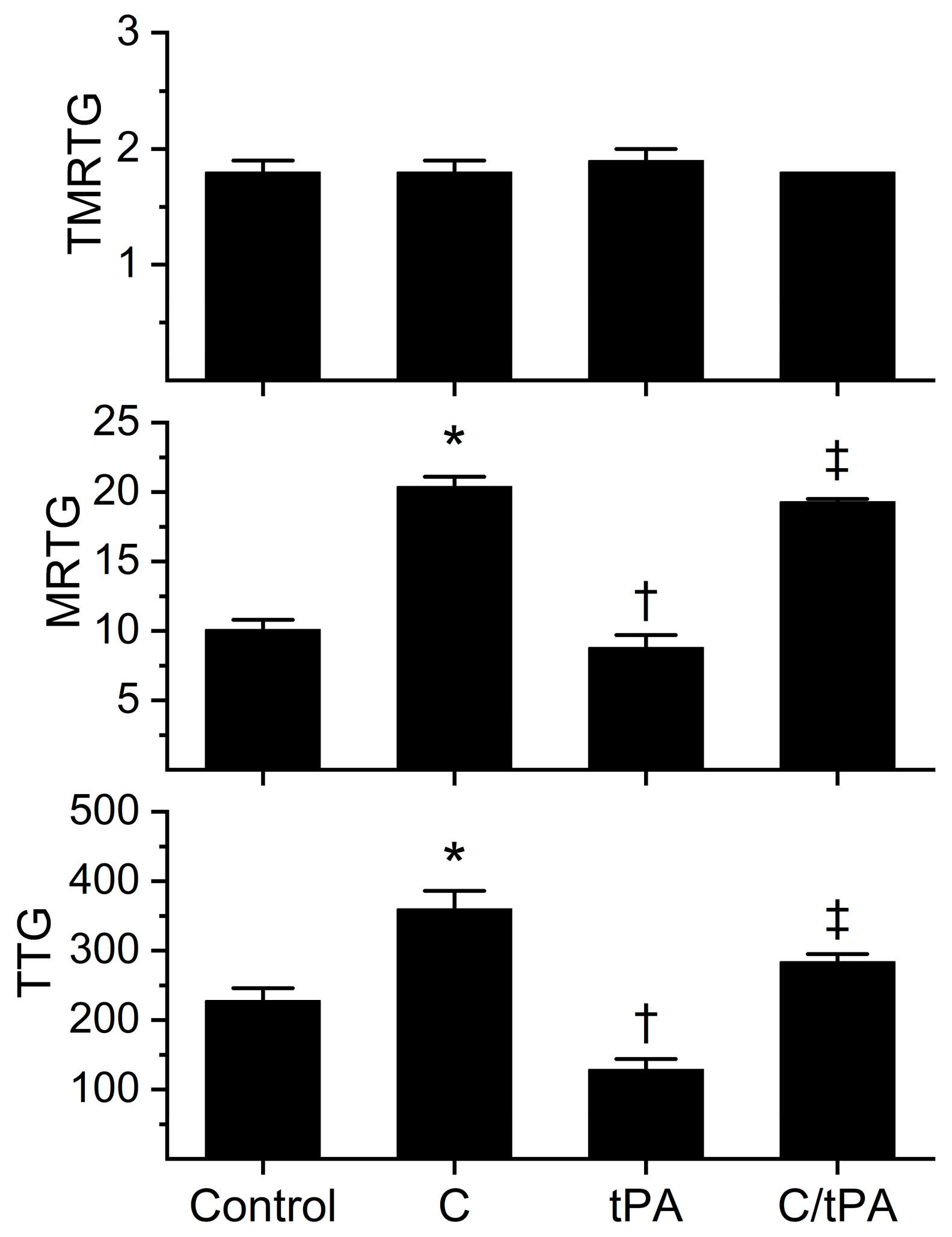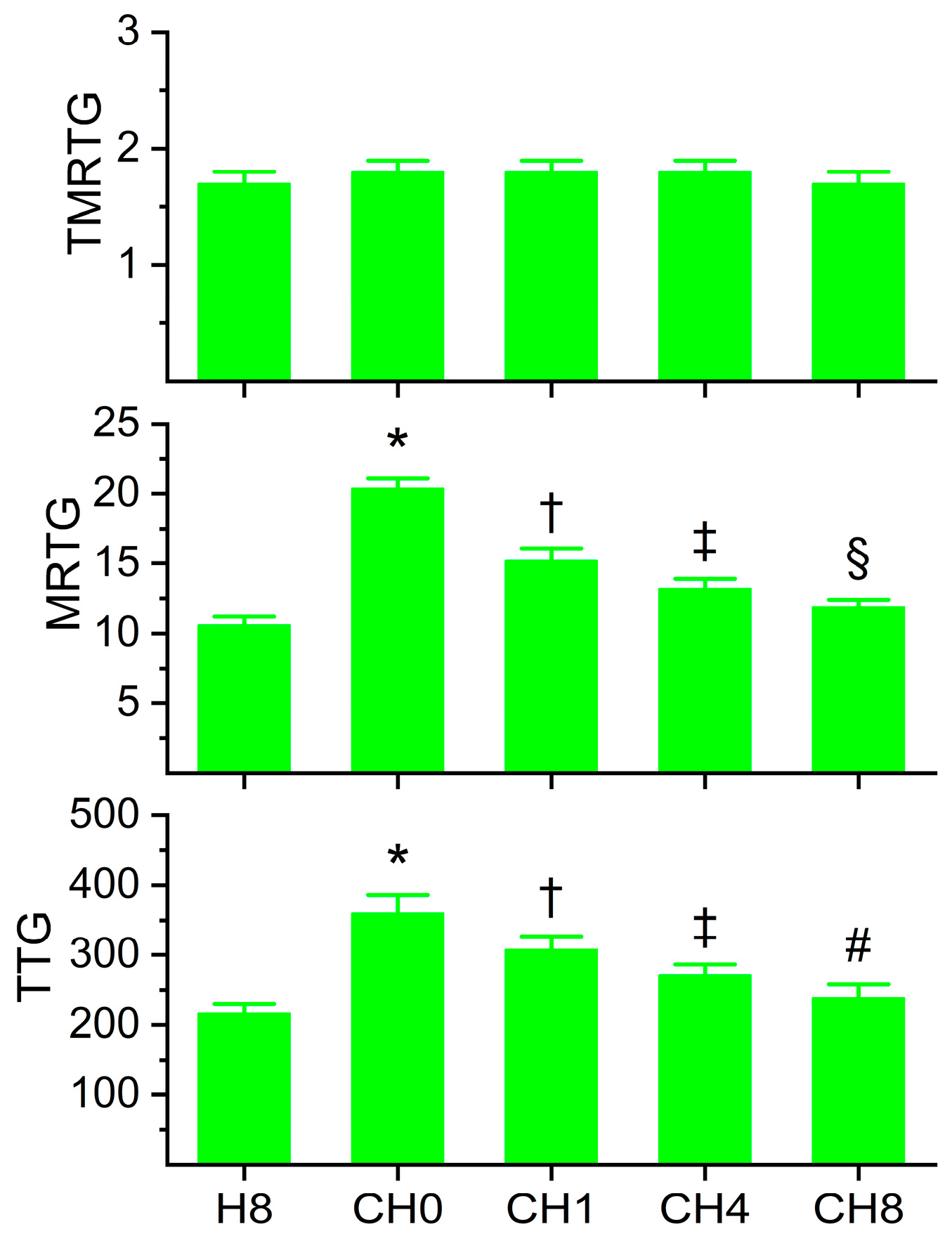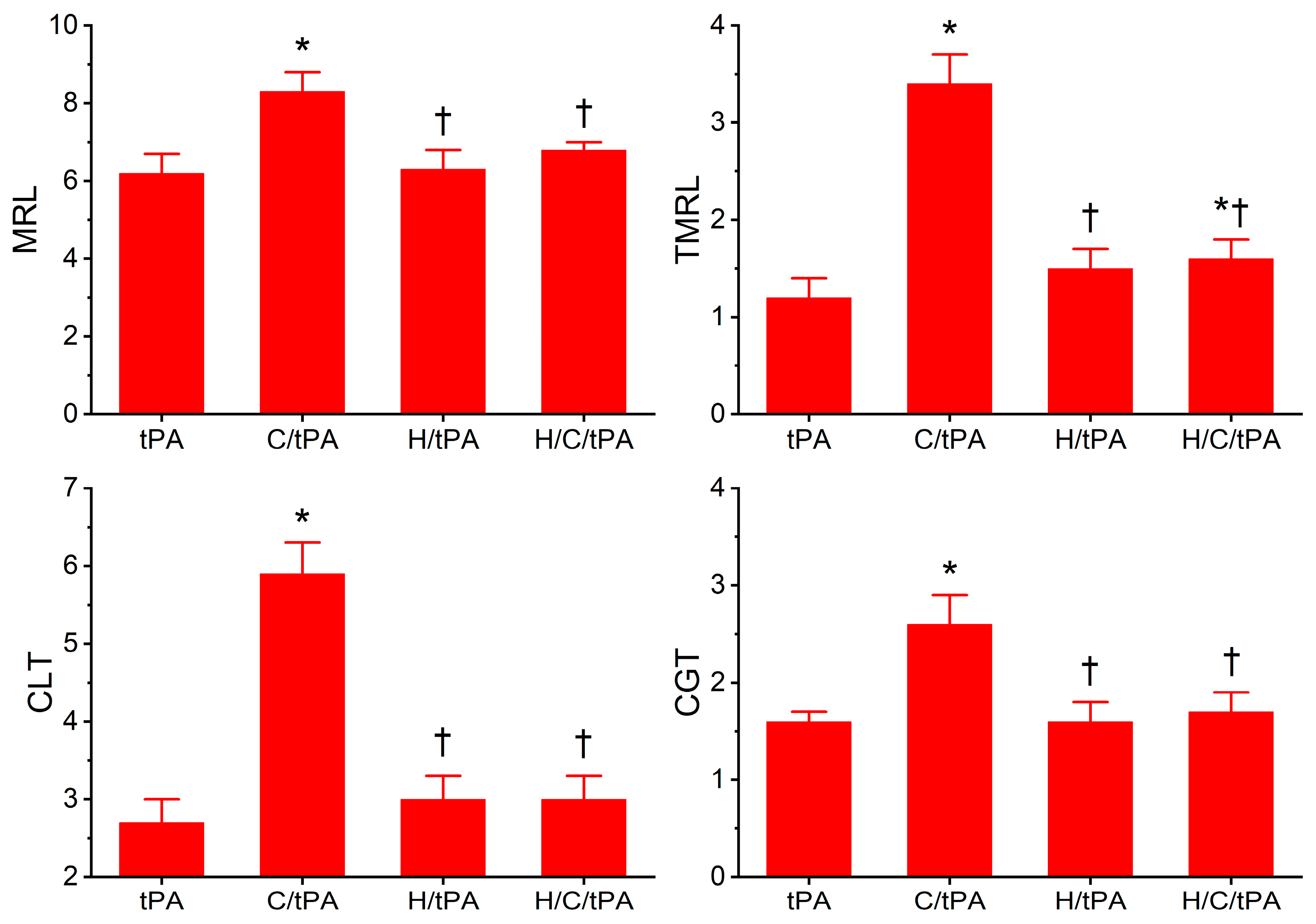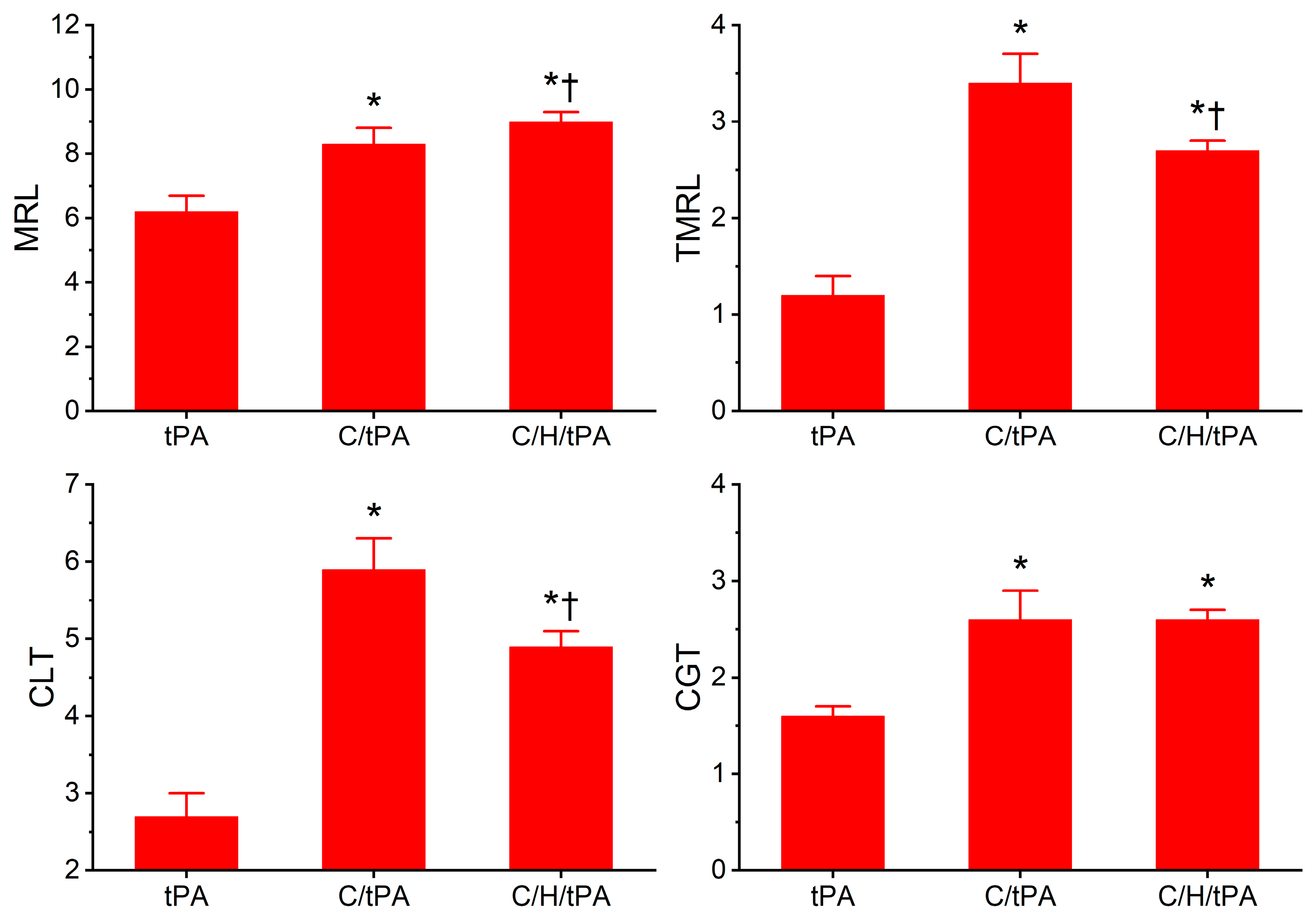Carbon Monoxide or Ruthenium: Will the Real Modulator of Coagulation and Fibrinolysis Please Stand Up!
Abstract
1. Introduction
2. Results
2.1. Comparison of Coagulation and Fibrinolysis Kinetics of Human Plasma Without or with tPA and Without or with CORM-2
2.2. Coagulation Kinetics of Human Plasma with Increasing Concentrations of Histidine
2.3. Coagulation Kinetics of Human Plasma with Increasing Concentrations of Histidine Prior to Addition of CORM-2
2.4. Comparison of Coagulation and Fibrinolysis Kinetics of Human Plasma with tPA, Without or with CORM-2, Without or with Histidine
2.5. Determination of Reversibility of CORM-2-Mediated Effects on Coagulation and Fibrinolysis Kinetics of Human Plasma with tPA by Exposing Plasma to CORM-2 Prior to Histidine Addition
3. Discussion
4. Materials and Methods
4.1. Plasma and Chemicals
4.2. Sample Compostion, Incubations, and Coagulation Monitoring
4.3. Statistical Analyses
Author Contributions
Funding
Institutional Review Board Statement
Informed Consent Statement
Data Availability Statement
Conflicts of Interest
References
- Ishimori, K.; Morishima, I. Ruthenium-iron hybrid hemoglobins as a model for partially liganded hemoglobin: NMR studies of their tertiary and quaternary structures. Biochemistry 1988, 27, 4060–4066. [Google Scholar] [CrossRef] [PubMed]
- Mansour, A.M.; Khaled, R.M.; Ferraro, G.; Shehab, O.R.; Merlino, A. Metal-based carbon monoxide releasing molecules with promising cytotoxic properties. Dalton Trans. 2024, 53, 9612–9656. [Google Scholar] [CrossRef] [PubMed]
- Opoku-Damoah, Y.; Zhang, R.; Ta, H.T.; Xu, Z.P. Therapeutic gas-releasing nanomedicines with controlled release: Advances and perspectives. Exploration 2022, 2, 20210181. [Google Scholar] [CrossRef] [PubMed]
- Khan, H.; Faizan, M.; Niazi, S.U.K.; Madiha Muhammad, N.; Zhang, W. Water-Soluble Carbon Monoxide-Releasing Molecules (CORMs). Top. Curr. Chem. 2022, 381, 3. [Google Scholar] [CrossRef]
- Motterlini, R.; Clark, J.E.; Foresti, R.; Sarathchandra, P.; Mann, B.E.; Green, C.J. Carbon monoxide-releasing molecules: Characterization of biochemical and vascular activities. Circ. Res. 2002, 90, E17–E24. [Google Scholar] [CrossRef]
- Clark, J.E.; Naughton, P.; Shurey, S.; Green, C.J.; Johnson, T.R.; Mann, B.E.; Foresti, R.; Motterlini, R. Cardioprotective actions by a water-soluble carbon monoxide-releasing molecule. Circ. Res. 2003, 93, e2–e8. [Google Scholar] [CrossRef]
- Nielsen, V.G.; Kirklin, J.K.; George, J.F. Carbon monoxide releasing molecule-2 increases the velocity of thrombus growth and strength in human plasma. Blood Coagul. Fibrinolysis 2009, 20, 377–380. [Google Scholar] [CrossRef]
- Nielsen, V.G.; Kirklin, J.K.; George, J.F. Carbon monoxide-releasing molecule-2 decreases fibrinolysis in human plasma. Blood Coagul. Fibrinolysis 2009, 20, 448–455. [Google Scholar] [CrossRef]
- Nielsen, V.G.; Kirklin, J.K.; George, J.F.; Messinger, J.D. Carbon monoxide releasing molecule-2 decreases thick diameter fibrin fibre formation in normal and Factor XIII deficient plasmas. Blood Coagul. Fibrinolysis 2010, 21, 101–105. [Google Scholar] [CrossRef]
- Nielsen, V.G.; Pretorius, E. Carbon monoxide: Anticoagulant or procoagulant? Thromb. Res. 2014, 133, 315–321. [Google Scholar] [CrossRef]
- Nielsen, V.G.; Chawla, N.; Mangla, D.; Gomes, S.B.; Arkebauer, M.R.; Wasko, K.A.; Sadacharam, K.; Vosseller, K. Carbon monoxide-releasing molecule-2 enhances coagulation in rabbit plasma and decreases bleeding time in clopidogrel/aspirin-treated rabbits. Blood Coagul. Fibrinolysis 2011, 22, 756–759. [Google Scholar] [CrossRef] [PubMed]
- Nielsen, V.G.; Arkebauer, M.R.; Wasko, K.A.; Malayaman, S.N.; Vosseller, K. Carbon monoxide-releasing molecule-2 decreases fibrinolysis in vitro and in vivo in the rabbit. Blood Coagul. Fibrinolysis 2012, 23, 104–107. [Google Scholar] [CrossRef] [PubMed]
- Nielsen, V.G.; Cohen, J.B.; Malayaman, S.N.; Nowak, M.; Vosseller, K. Fibrinogen is a heme-associated, carbon monoxide sensing molecule: A preliminary report. Blood Coagul. Fibrinolysis 2011, 22, 443–447. [Google Scholar] [CrossRef] [PubMed]
- Arkebauer, M.R.; Kanaparthy, S.S.; Malayaman, S.N.; Vosseller, K.; Nielsen, V.G. Carbon monoxide and nitric oxide modulate α2-antiplasmin and plasmin activity: Role of heme. Blood Coagul. Fibrinolysis 2011, 22, 712–719. [Google Scholar] [CrossRef]
- Malayaman, S.N.; Cohen, J.B.; Machovec, K.A.; Bernhardt, B.E.; Arkebauer, M.R.; Nielsen, V.G. Carbon monoxide releasing molecule-2 enhances α2-antiplasmin activity. Blood Coagul. Fibrinolysis 2011, 22, 345–348. [Google Scholar] [CrossRef]
- Nielsen, V.G. Nitric oxide decreases coagulation protein function in rabbits as assessed by thromboelastography. Anesth. Analg. 2001, 92, 320–323. [Google Scholar] [CrossRef]
- Helms, C.C.; Kapadia, S.; Gilmore, A.C.; Lu, Z.; Basu, S.; Kim-Shapiro, D.B. Exposure of fibrinogen and thrombin to nitric oxide donor ProliNONOate affects fibrin clot properties. Blood Coagul. Fibrinolysis 2017, 28, 356–364. [Google Scholar] [CrossRef]
- Nielsen, V.G.; Garza, J.I. Comparison of the effects of CORM-2, CORM-3 and CORM-A1 on coagulation in human plasma. Blood Coagul. Fibrinolysis 2014, 25, 801–805. [Google Scholar] [CrossRef]
- Ali, S.; Farooqi, H.; Prasad, R.; Naime, M.; Routray, I.; Yadav, S.; Ahmad, F. Boron stabilizes peroxide mediated changes in the structure of heme proteins. Int. J. Biol. Macromol. 2010, 47, 109–115. [Google Scholar] [CrossRef]
- Gessner, G.; Sahoo, N.; Swain, S.M.; Hirth, G.; Schönherr, R.; Mede, R.; Westerhausen, M.; Brewitz, H.H.; Heimer, P.; Imhof, D.; et al. CO-independent modification of K+ channels by tricarbonyldichlororuthenium(II) dimer (CORM-2). Eur. J. Pharmacol. 2017, 815, 33–41. [Google Scholar] [CrossRef]
- Meloun, B.; Morávek, L.; Kostka, V. Complete amino acid sequence of human serum albumin. FEBS Lett. 1975, 58, 134–137. [Google Scholar] [CrossRef] [PubMed]
- Nielsen, V.G. The anticoagulant effect of Apis mellifera phospholipase A2 is inhibited by CORM-2 via a carbon monoxide-independent mechanism. J. Thromb. Thrombolysis 2020, 49, 100–107. [Google Scholar] [CrossRef] [PubMed]
- Nielsen, V.G. Phosphate-Buffered Saline and Dimethyl Sulfoxide Enhance the Antivenom Action of Ruthenium Chloride against Crotalus atrox Venom in Human Plasma—A Preliminary Report. Int. J. Mol. Sci. 2024, 25, 6426. [Google Scholar] [CrossRef] [PubMed]
- Nazarov, A.A.; Mendoza-Ferri, M.G.; Hanif, M.; Keppler, B.K.; Dyson, P.J.; Hartinger, C.G. Understanding the interactions of diruthenium anticancer agents with amino acids. J. Biol. Inorg. Chem. 2018, 23, 1159–1164. [Google Scholar] [CrossRef]
- Blombäck, B.; Blombäck, M. The molecular structure of fibrinogen. Ann. N. Y. Acad. Sci. 1972, 202, 77–97. [Google Scholar] [CrossRef]
- Doolittle, R.F. Structure and function of fibrinogen. Horiz. Biochem. Biophys. 1977, 3, 164–191. [Google Scholar]
- Robbins, K.C.; Bernabe, P.; Arzadon, L.; Summaria, L. The primary structure of human plasminogen. I. The NH 2 -terminal sequences of human plasminogen and the S-carboxymethyl heavy (A) and light (B) chain derivatives of plasmin. J. Biol. Chem. 1972, 247, 6757–6762. [Google Scholar] [CrossRef]
- Robbins, K.C.; Bernabe, P.; Arzadon, L.; Summaria, L. The primary structure of human plasminogen. II. The histidine loop of human plasmin: Light (B) chain active center histidine sequence. J. Biol. Chem. 1973, 248, 1631–1633. [Google Scholar] [CrossRef]
- Lijnen, H.R.; Holmes, W.E.; van Hoe, F.B.; Wiman, B.; Rodriguez, H.; Collen, D. Amino-acid sequence of human alpha 2-antiplasmin. Eur. J. Biochem. 1987, 166, 565–574. [Google Scholar] [CrossRef]
- Fasano, M.; Curry, S.; Terreno, E.; Galliano, M.; Fanali, G.; Narciso, P.; Notari, S.; Ascenzi, P. The extraordinary ligand binding properties of human serum albumin. IUBMB Life 2005, 57, 787–796. [Google Scholar] [CrossRef]
- Nielsen, V.G. Colloids decrease clot propagation and strength: Role of factor XIII-fibrin polymer and thrombin-fibrinogen interactions. Acta Anaesthesiol. Scand. 2005, 49, 1163–1171. [Google Scholar] [CrossRef] [PubMed]
- Morris, D.L.; Dudley, M.D.; Pearson, R.D. Coagulopathy associated with hematin treatment for acute intermittent porphyria. Ann. Intern. Med. 1981, 95, 700–701. [Google Scholar] [CrossRef] [PubMed]
- Glueck, R.; Green, D.; Cohen, I.; Ts’ao, C.H. Hematin: Unique effects of hemostasis. Blood 1983, 61, 243–249. [Google Scholar] [CrossRef] [PubMed]
- Dobrovolsky, A.B.; Titaeva, E.V. The fibrinolysis system: Regulation of activity and physiologic functions of its main components. Biochemistry 2002, 67, 99–108. [Google Scholar]
- Stanyon, H.F.; Viles, J.H. Human serum albumin can regulate amyloid-β peptide fiber growth in the brain interstitium: Implications for Alzheimer disease. J. Biol. Chem. 2012, 287, 28163–28168. [Google Scholar] [CrossRef]
- Brosnan, M.E.; Brosnan, J.T. Histidine Metabolism and Function. J. Nutr. 2020, 150 (Suppl. S1), 2570S–2575S. [Google Scholar] [CrossRef]
- Wolberg, A.S. Fibrinogen and fibrin: Synthesis, structure, and function in health and disease. J. Thromb. Haemost. 2023, 21, 3005–3015. [Google Scholar] [CrossRef]
- Keragala, C.B.; Medcalf, R.L. Plasminogen: An enigmatic zymogen. Blood 2021, 137, 2881–2889. [Google Scholar] [CrossRef]
- Reed, G.L.; Houng, A.K.; Singh, S.; Wang, D. α2-Antiplasmin: New Insights and Opportunities for Ischemic Stroke. Semin. Thromb. Hemost. 2017, 43, 191–199. [Google Scholar]








| Manuscripts | Citations 1 |
|---|---|
| Blood Coagul. Fibrinolysis. 2009, 20, 377–380. | 30 |
| Blood Coagul. Fibrinolysis. 2009, 20, 448–455. | 21 |
| Blood Coagul. Fibrinolysis. 2010, 21, 41–45. | 6 |
| Blood Coagul. Fibrinolysis. 2010, 21, 101–105. | 12 |
| Blood Coagul. Fibrinolysis. 2010, 21, 298–299. | 2 |
| Thromb. Res. 2010, 126, 68–73. | 5 |
| Blood Coagul. Fibrinolysis. 2010, 21, 349–353. | 11 |
| Blood Coagul. Fibrinolysis. 2010, 21, 584–587. | 10 |
| Anesth. Analg. 2010, 111, 1347–1352. | 4 |
| J. Trauma. 2011, 70, 939–947 | 3 |
| Blood Coagul. Fibrinolysis. 2011, 22, 60–66. | 6 |
| Blood Coagul. Fibrinolysis. 2011, 22, 345–348. | 11 |
| Blood Coagul. Fibrinolysis. 2011, 22, 362–368. | 2 |
| Blood Coagul. Fibrinolysis. 2011, 22, 443–447. | 23 |
| Blood Coagul. Fibrinolysis. 2011, 22, 657–661. | 15 |
| Blood Coagul. Fibrinolysis. 2011, 22, 712–719. | 13 |
| Blood Coagul. Fibrinolysis. 2011, 22, 756–759. | 13 |
| J. Surg. Res. 2012, 173, 232–239. | 9 |
| Thromb. Res. 2012, 129, 793–796. | 7 |
| Blood Coagul. Fibrinolysis. 2012, 23, 104–107. | 12 |
| Blood Coagul. Fibrinolysis. 2013, 24, 273–278. | 6 |
| ASAIO J. 2013, 59, 93–95. | 7 |
| Blood Coagul. Fibrinolysis. 2013, 24, 381–385. | 7 |
| Blood Coagul. Fibrinolysis. 2013, 24, 405–410. | 56 |
| Blood Coagul. Fibrinolysis. 2013, 24, 663–665. | 11 |
| Artif. Organs. 2013, 37, 1008–1014. | 10 |
| Blood Coagul. Fibrinolysis. 2013, 24, 809–813. | 13 |
| Lung Cancer. 2014, 83, 288–291. | 5 |
| Thromb. Res. 2014, 133, 315–321. | 25 |
| Anesth. Analg. 2014, 118, 919–924. | 7 |
| Blood Coagul. Fibrinolysis. 2014, 25, 435–438. | 5 |
| Blood Coagul. Fibrinolysis. 2014, 25, 621–624. | 7 |
| Blood Coagul. Fibrinolysis. 2014, 25, 695–702. | 26 |
| Blood Coagul. Fibrinolysis. 2014, 25, 801–805. | 24 |
| ASAIO J. 2014, 60, 716–721. | 9 |
| J. Thromb. Thrombolysis. 2015, 39, 532–535. | 2 |
| Blood Coagul. Fibrinolysis. 2015, 26, 200–204. | 9 |
| Curr. Neurovasc. Res. 2015, 12, 31–39. | 18 |
| ASAIO J. 2015, 61, 417–423. | 6 |
| CNS Neurol. Disord. Drug Targets. 2015, 14, 1079–1085. | 2 |
| Parameter | Condition | Value |
|---|---|---|
| CGT | tPA | 1.6 ± 0.1 |
| tPA+CORM-2 | 2.6 ± 0.3 * | |
| TMRL | tPA | 1.2 ± 0.2 |
| tPA+CORM-2 | 3.4 ± 0.3 * | |
| MRL | tPA | 6.2 ± 0.5 |
| tPA+CORM-2 | 8.3 ± 0.5 * | |
| CLT | tPA | 2.7 ± 0.3 |
| tPA+CORM-2 | 5.9 ± 0.4 * |
Disclaimer/Publisher’s Note: The statements, opinions and data contained in all publications are solely those of the individual author(s) and contributor(s) and not of MDPI and/or the editor(s). MDPI and/or the editor(s) disclaim responsibility for any injury to people or property resulting from any ideas, methods, instructions or products referred to in the content. |
© 2025 by the authors. Licensee MDPI, Basel, Switzerland. This article is an open access article distributed under the terms and conditions of the Creative Commons Attribution (CC BY) license (https://creativecommons.org/licenses/by/4.0/).
Share and Cite
Nielsen, V.G.; Abeyta, A.R. Carbon Monoxide or Ruthenium: Will the Real Modulator of Coagulation and Fibrinolysis Please Stand Up! Int. J. Mol. Sci. 2025, 26, 3567. https://doi.org/10.3390/ijms26083567
Nielsen VG, Abeyta AR. Carbon Monoxide or Ruthenium: Will the Real Modulator of Coagulation and Fibrinolysis Please Stand Up! International Journal of Molecular Sciences. 2025; 26(8):3567. https://doi.org/10.3390/ijms26083567
Chicago/Turabian StyleNielsen, Vance G., and Anthony R. Abeyta. 2025. "Carbon Monoxide or Ruthenium: Will the Real Modulator of Coagulation and Fibrinolysis Please Stand Up!" International Journal of Molecular Sciences 26, no. 8: 3567. https://doi.org/10.3390/ijms26083567
APA StyleNielsen, V. G., & Abeyta, A. R. (2025). Carbon Monoxide or Ruthenium: Will the Real Modulator of Coagulation and Fibrinolysis Please Stand Up! International Journal of Molecular Sciences, 26(8), 3567. https://doi.org/10.3390/ijms26083567






